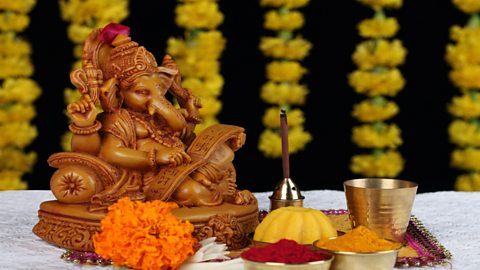Worship at home
The shrine
A lot of Hindus worship every day at home, at a shrine in their house. The shrine is usually kept in the cleanest room in the house to show respect to BrahmanIn Hindu belief, the absolute reality that is the true essence of all existence, God.. However, the most important thing is to make sure that all members of the family can take part in daily worshipTo show devotion to God and/or religion through actions - for example, prayer..
The shrine will contain important objects that are used for worship. The most important type of worship is the pujaThe word most Hindus use for an act of daily worship. ceremony, which uses all five senses. For this a Hindu needs the following:
| Object | Use in worship | Sense used |
| A bell | To awaken the god and let them know you are ready to worship. | Hearing |
| Food offerings | Food, usually fruit, is given as an offering to the gods. | Taste |
| Murti | A image or statue of the god being worshipped. | Sight |
| Incense | Incense is burnt. It fills the room, which reminds worshippers that Brahman is always there. Incense is also burnt to purify the atmosphere. | Smell |
| Kum-kum powder | Marks the head of the worshipper and the god to show respect. | Touch |
| Object | A bell |
|---|---|
| Use in worship | To awaken the god and let them know you are ready to worship. |
| Sense used | Hearing |
| Object | Food offerings |
|---|---|
| Use in worship | Food, usually fruit, is given as an offering to the gods. |
| Sense used | Taste |
| Object | Murti |
|---|---|
| Use in worship | A image or statue of the god being worshipped. |
| Sense used | Sight |
| Object | Incense |
|---|---|
| Use in worship | Incense is burnt. It fills the room, which reminds worshippers that Brahman is always there. Incense is also burnt to purify the atmosphere. |
| Sense used | Smell |
| Object | Kum-kum powder |
|---|---|
| Use in worship | Marks the head of the worshipper and the god to show respect. |
| Sense used | Touch |

Other objects placed in a home shrine can include water and divaLamps made of cotton wool and purified butter (ghee), lit for worship and for special occasions, eg Divali. candles or lights.
The bell is rung, which indicates the start of the puja ceremony. The incense is lit, which fills the room with a scent to show that God is everywhere. The feet of the murtiA statue of a god or goddess which has been made holy through a special ceremony; a term for any statue of a god or goddess. are then washed to show that the god is welcomed and as a sign of respect. Flowers are offered to the god to show its importance.
Hymns or mantras are said as another way of showing devotion to the gods. Then the worshipper takes some kum-kum powder and places it on their forehead and the head of the murti as a blessing. Sweet foods or fruits are offered to the deity, which is then thought to be blessed.
Like when the puja ceremony is carried out in the temple, an arti (arati)An act of worship and of adoration, using diva lamps made from cotton wool and ghee (purified butter). lamp is lit and circled around the front of the god as light represents love and devotion to the god. The aarti lamp is usually waved in front of the deity / deitiesOne god or goddess. In Hinduism, the word for gods and goddesses that many Hindus believe are different aspects of the one Supreme Spirit (Brahman). at the end of the puja.